Financial News
EnerSys’s (NYSE:ENS) Q2: Beats On Revenue

Battery manufacturer EnerSys (NYSE: ENS) reported Q2 CY2025 results beating Wall Street’s revenue expectations, with sales up 4.7% year on year to $893 million. On the other hand, next quarter’s revenue guidance of $890 million was less impressive, coming in 1.2% below analysts’ estimates. Its non-GAAP profit of $2.08 per share was 1.3% above analysts’ consensus estimates.
Is now the time to buy EnerSys? Find out by accessing our full research report, it’s free.
EnerSys (ENS) Q2 CY2025 Highlights:
- Revenue: $893 million vs analyst estimates of $848.1 million (4.7% year-on-year growth, 5.3% beat)
- Adjusted EPS: $2.08 vs analyst estimates of $2.05 (1.3% beat)
- Adjusted EBITDA: $123.3 million vs analyst estimates of $127.6 million (13.8% margin, 3.4% miss)
- Revenue Guidance for Q3 CY2025 is $890 million at the midpoint, below analyst estimates of $901.1 million
- Adjusted EPS guidance for Q3 CY2025 is $2.38 at the midpoint, roughly in line with what analysts were expecting
- Operating Margin: 9.7%, down from 10.7% in the same quarter last year
- Free Cash Flow was -$32.05 million compared to -$25.85 million in the same quarter last year
- Sales Volumes rose 1% year on year (-3% in the same quarter last year)
- Market Capitalization: $3.57 billion
"We delivered revenue of $893 million in the first quarter, up 5% year-over-year with adjusted diluted EPS of $2.08,” said Shawn O’Connell, President and Chief Executive Officer of EnerSys.
Company Overview
Supplying batteries that power equipment as big as mining rigs, EnerSys (NYSE: ENS) manufactures various kinds of batteries for a range of industries.
Revenue Growth
A company’s long-term sales performance can indicate its overall quality. Any business can experience short-term success, but top-performing ones enjoy sustained growth for years. Regrettably, EnerSys’s sales grew at a sluggish 4% compounded annual growth rate over the last five years. This was below our standard for the industrials sector and is a tough starting point for our analysis.
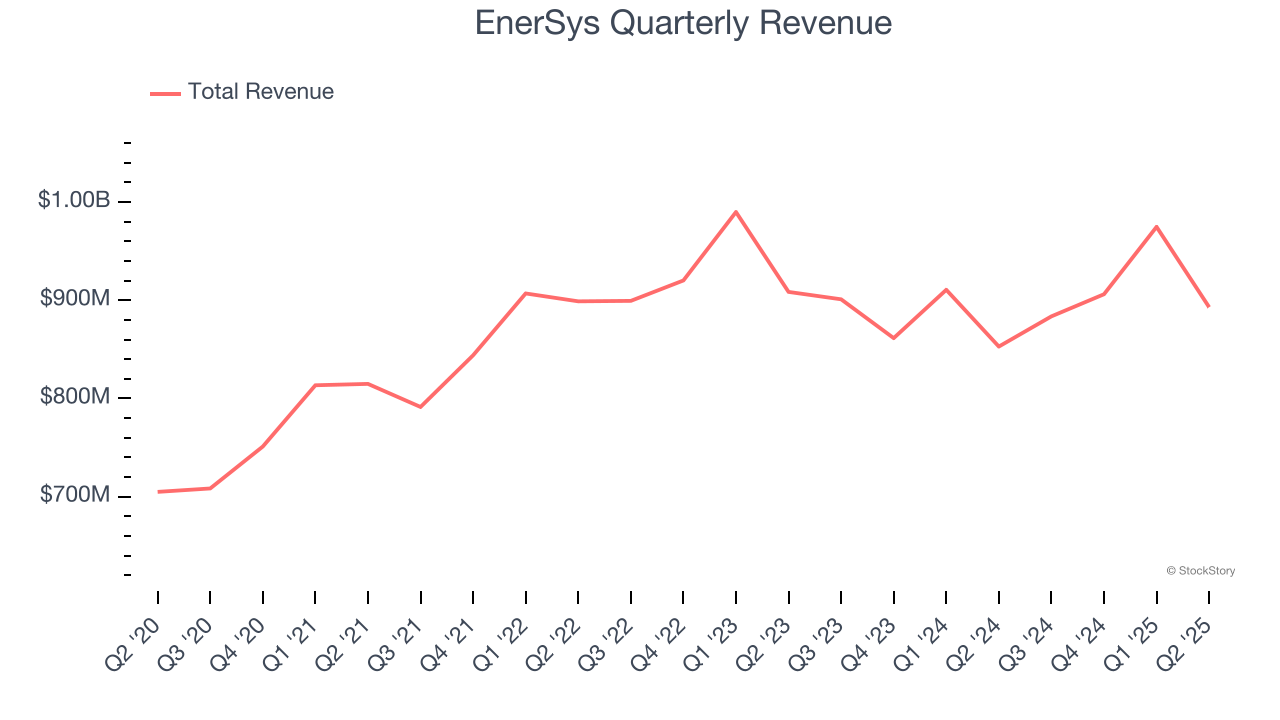
We at StockStory place the most emphasis on long-term growth, but within industrials, a half-decade historical view may miss cycles, industry trends, or a company capitalizing on catalysts such as a new contract win or a successful product line. EnerSys’s recent performance shows its demand has slowed as its revenue was flat over the last two years. We also note many other Renewable Energy businesses have faced declining sales because of cyclical headwinds. While EnerSys’s growth wasn’t the best, it did do better than its peers. 
We can dig further into the company’s revenue dynamics by analyzing its number of units sold. Over the last two years, EnerSys’s units sold averaged 2.5% year-on-year declines. Because this number is lower than its revenue growth, we can see the company benefited from price increases. 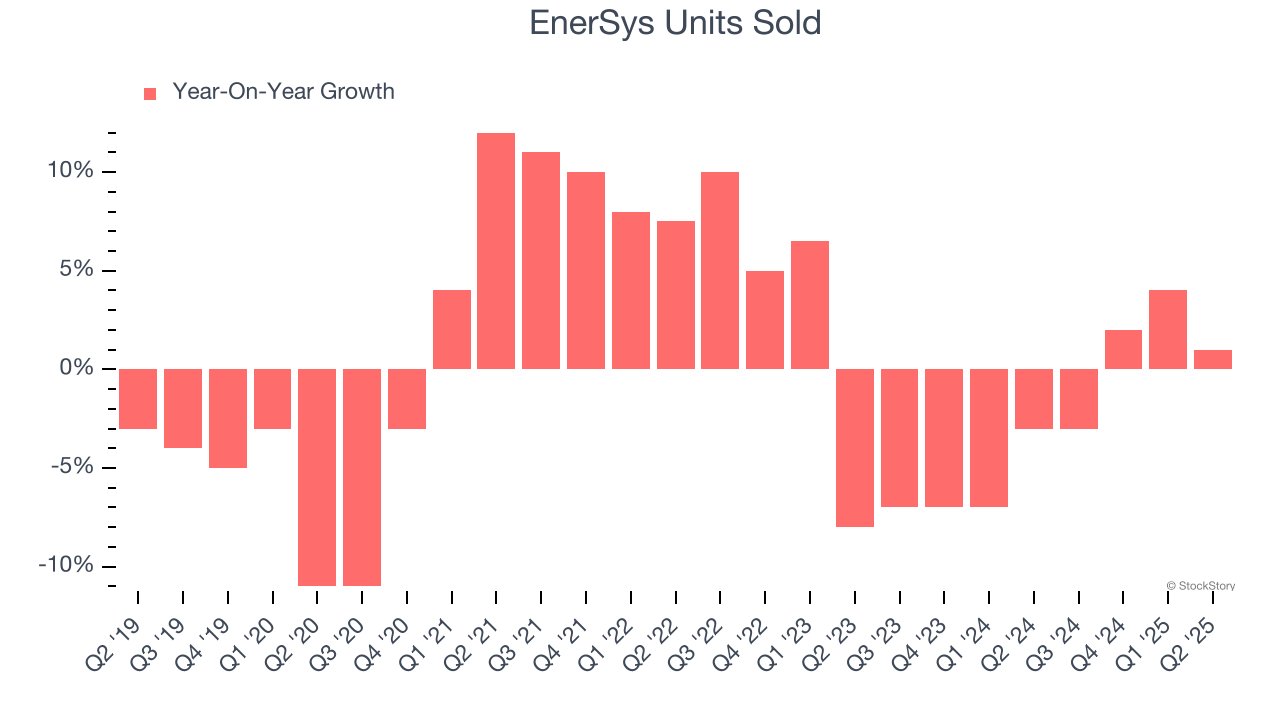
This quarter, EnerSys reported modest year-on-year revenue growth of 4.7% but beat Wall Street’s estimates by 5.3%. Company management is currently guiding for flat sales next quarter.
Looking further ahead, sell-side analysts expect revenue to grow 2.1% over the next 12 months. While this projection suggests its newer products and services will fuel better top-line performance, it is still below the sector average.
Unless you’ve been living under a rock, it should be obvious by now that generative AI is going to have a huge impact on how large corporations do business. While Nvidia and AMD are trading close to all-time highs, we prefer a lesser-known (but still profitable) stock benefiting from the rise of AI. Click here to access our free report one of our favorites growth stories.
Operating Margin
Operating margin is one of the best measures of profitability because it tells us how much money a company takes home after procuring and manufacturing its products, marketing and selling those products, and most importantly, keeping them relevant through research and development.
EnerSys has done a decent job managing its cost base over the last five years. The company has produced an average operating margin of 8.9%, higher than the broader industrials sector.
Looking at the trend in its profitability, EnerSys’s operating margin rose by 5.3 percentage points over the last five years, as its sales growth gave it operating leverage.
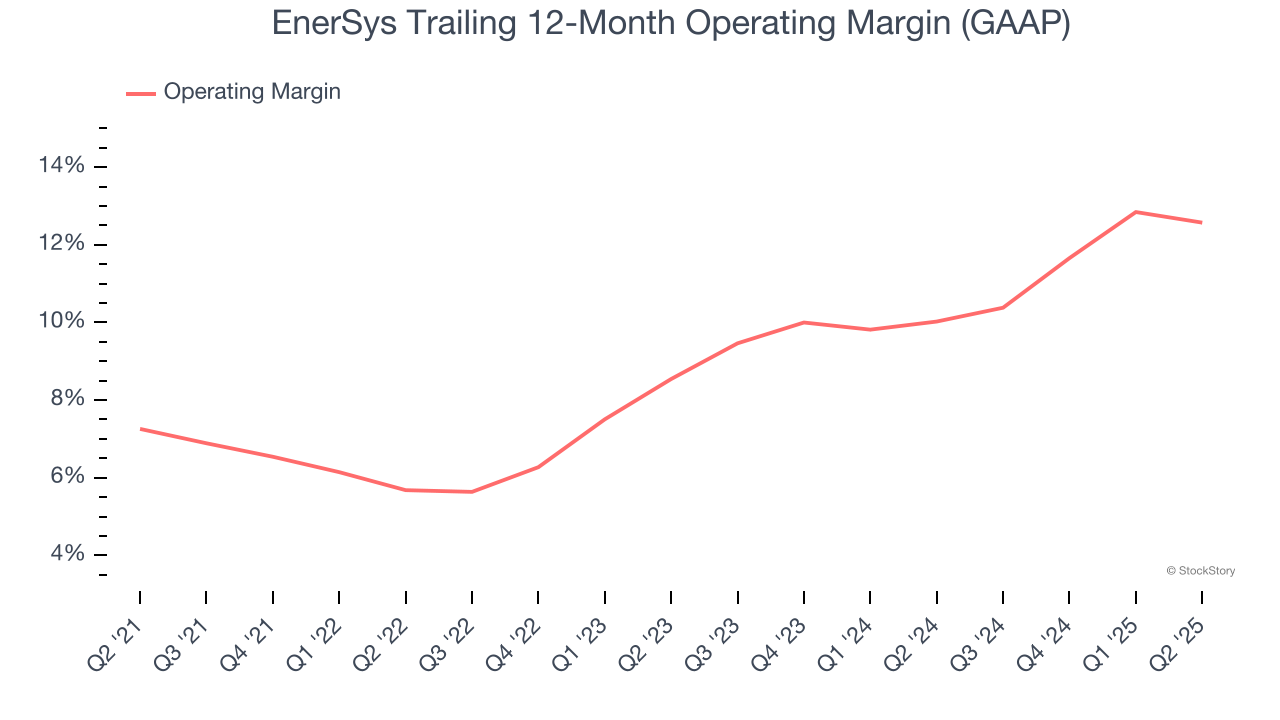
In Q2, EnerSys generated an operating margin profit margin of 9.7%, down 1 percentage points year on year. Since EnerSys’s operating margin decreased more than its gross margin, we can assume it was less efficient because expenses such as marketing, R&D, and administrative overhead increased.
Earnings Per Share
Revenue trends explain a company’s historical growth, but the long-term change in earnings per share (EPS) points to the profitability of that growth – for example, a company could inflate its sales through excessive spending on advertising and promotions.
EnerSys’s EPS grew at an astounding 19.1% compounded annual growth rate over the last five years, higher than its 4% annualized revenue growth. This tells us the company became more profitable on a per-share basis as it expanded.
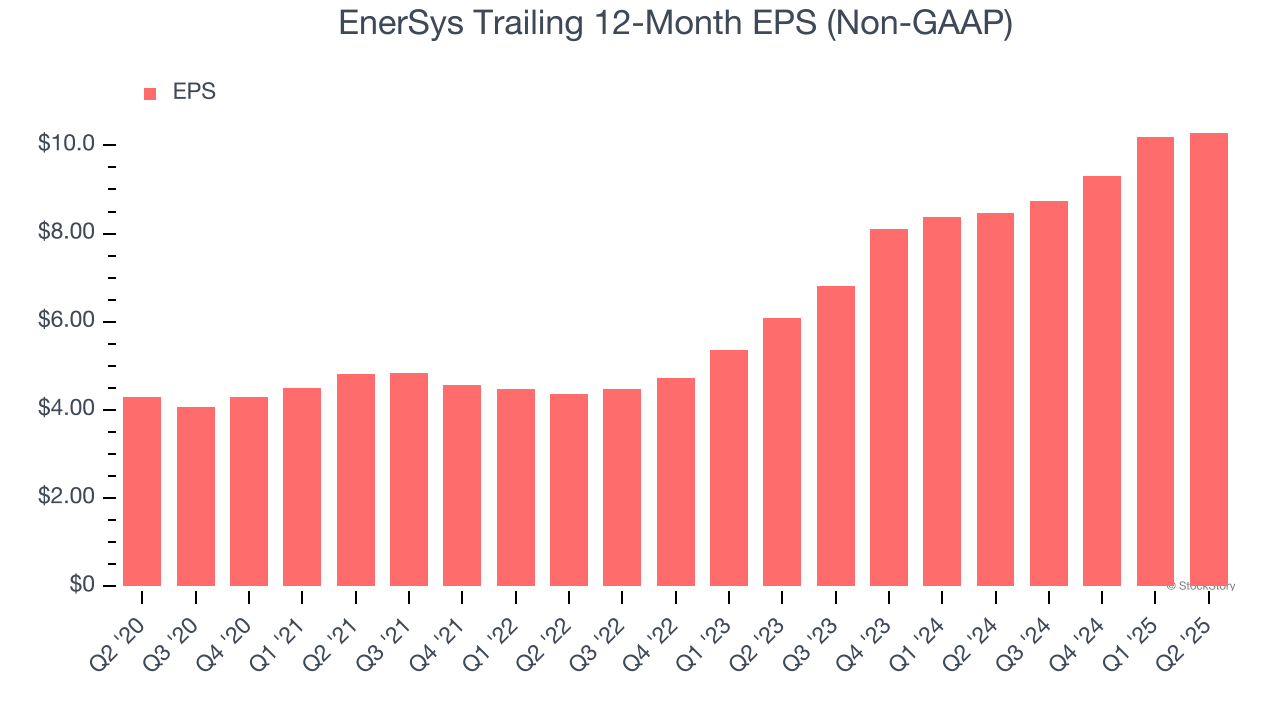
We can take a deeper look into EnerSys’s earnings to better understand the drivers of its performance. As we mentioned earlier, EnerSys’s operating margin declined this quarter but expanded by 5.3 percentage points over the last five years. Its share count also shrank by 8.5%, and these factors together are positive signs for shareholders because improving profitability and share buybacks turbocharge EPS growth relative to revenue growth. 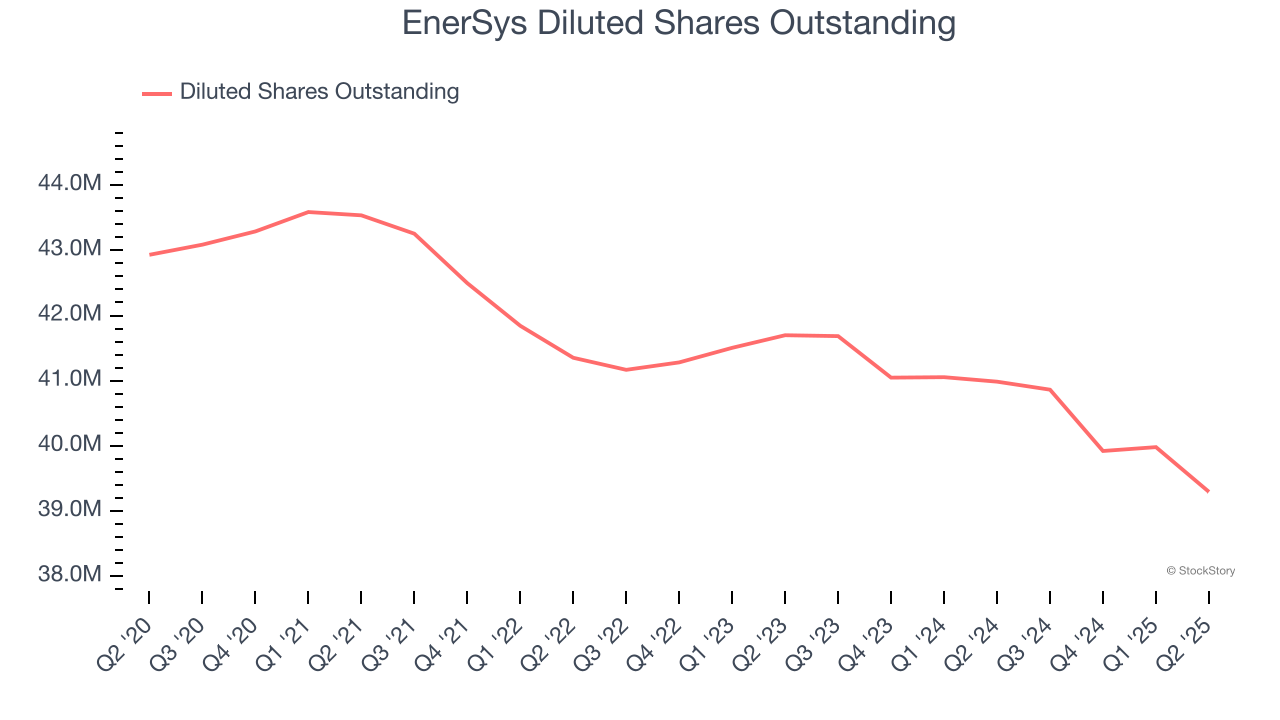
Like with revenue, we analyze EPS over a more recent period because it can provide insight into an emerging theme or development for the business.
For EnerSys, its two-year annual EPS growth of 30% was higher than its five-year trend. We love it when earnings growth accelerates, especially when it accelerates off an already high base.
In Q2, EnerSys reported adjusted EPS at $2.08, up from $1.98 in the same quarter last year. This print beat analysts’ estimates by 1.3%. We also like to analyze expected EPS growth based on Wall Street analysts’ consensus projections, but there is insufficient data.
Key Takeaways from EnerSys’s Q2 Results
We were impressed by how significantly EnerSys blew past analysts’ sales volume expectations this quarter. We were also excited its revenue outperformed Wall Street’s estimates by a wide margin. On the other hand, its EBITDA missed and its revenue guidance for next quarter fell slightly short of Wall Street’s estimates. Overall, this print was mixed. The stock remained flat at $91.13 immediately after reporting.
So should you invest in EnerSys right now? When making that decision, it’s important to consider its valuation, business qualities, as well as what has happened in the latest quarter. We cover that in our actionable full research report which you can read here, it’s free.
More News
View More





Quotes delayed at least 20 minutes.
By accessing this page, you agree to the following
Privacy Policy and Terms Of Service.



